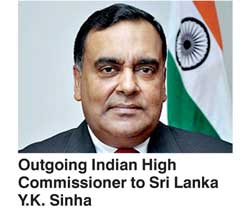Friday Jan 03, 2025
Friday Jan 03, 2025
Thursday, 22 September 2016 00:01 - - {{hitsCtrl.values.hits}}
By Madushka Balasuriya
The Indian Government yesterday sought to reassure Sri Lanka that India’s burgeoning investment on developing its ports will pose no threat to the Port of Colombo, noting they have urged Indian companies to invest in the expansion of the Colombo Harbour.
“There is a fear that once India develops its infrastructures and, particularly, ports in the eastern and western coasts, they will prove to have a detrimental impact on the Colombo Port. I do not believe that will happen,” said outgoing Indian High Commissioner to Sri Lanka Y.K. Sinha, speaking on the opening day of the Colombo International Maritime Conference last evening.
“At the rate that India is going it will need all the ports that it can use for transporting or receiving its cargo as part of its imports. I think the Colombo Port will play an extremely important role in India’s global trade in the foreseeable future.
“It is with that in mind that the Indian Government has encouraged Indian companies to invest in the expansion of the Colombo Port. We believe this expansion will be good for Sri Lanka, will be good for India and will be good for the region,” he added.
At present India relies considerably on the Port of Colombo for its global trade, with 30% of their total global transshipment on average going through Colombo Harbour, which itself is 70% of the port’s total transshipment. The figures are even greater for 2015, with Colombo handling the largest share of India’s foreign transshipment - 48%. It is in this context that CEO Aitken Spence Maritime Dr. Parakrama Dissanayake was wary of the Indian Government’s recent moves towards developing their coastal regions, most notably the International Container Transhipment Terminal in Vallarpadam and the under construction Vizhinjam transshipment port in Trivandrum, India.
“It is true that transshipment volumes off the Port of Colombo is dominated by Indian traffic, but having said that the former Prime Minister of India personally launched the Port of Vallarpadam in South India as the main Indian transshipment hub,” noted Dissanayake.
“But for various reasons Vallarpadam couldn’t pose a threat to the port of Colombo. Now when the Vizhinjam port is completed it will be able to handle ships with a capacity of 18000-20000 TEUs,” he added, also drawing attention to ‘Delhi’s Big Bet’ on transshipment traffic in Enayam, where the Indian Government has been seeking cabinet approval to build a deep sea port.
Along with plans to build a port at Vadhavan in Maharashstra, the moves are part of the Indian Government’s renewed focus on developing the country’s infrastructure. Ten coastal regions in total have been earmarked for development - including the hinterland and the transportation links from the hinterland to the ports - both on the eastern and western seaboards. These developments Dissanayake said raises a key question: “Can these three ports take off the gloss off the Port of Colombo?”
“Only time will tell,” he acknowledged, but said he was brought a certain amount of relief by the fact that two of India’s biggest companies, Tata Sons and Shapoorji Pallonji Group, have shown interest in investing in the development of the east container terminal at the Colombo port.
The Colombo International Maritime Conference is in its second year and will be held over three days from 21-23 September, and is being held in line with Sri Lanka Maritime Week from 21-27 September. Over 35 international speakers are expected to address the conference along with several senior Government ministers.